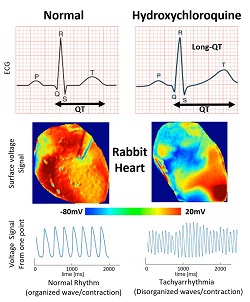An optical mapping system has demonstrated that hydroxychloroquine (HCQ) can cause arrhythmia in animals, so researchers and clinicians are cautious about its effectiveness as a treatment of COVID-19 in people. Previously, HCQ, a less toxic form of chloroquine (CQ), has been prescribed to those with malaria and various autoimmune conditions and has showed some promise in reducing COVID-19 symptoms in a limited number of cases.

Images show the voltage surface on a rabbit heart with and without HCQ. Without the drug (normal), the electrical activation spreads homogeneously, while with HCQ, waves propagate unevenly, generating complex spatiotemporal patters and arrhythmias. Courtesy of Georgia Tech School of Physics.
But with the aid of a setup based on LED lights, filters, and voltage-sensitive fluorescent dye, a team of researchers saw a worrying level of arrhythmia in rabbit and guinea pig hearts. After the administration of a 1000 ng/mL of HCQ (at the upper end of a typical therapeutic dose) into a solution to which the hearts were subjected, QT prolongation was observed. QT prolongation is the lengthening of time beginning from the start of the “Q” wave and continuing through the end of the “T” wave in a typical heartbeat.
Flavio Fenton, a professor in the Georgia Institute of Technology School of Physics and a corresponding author of the study, indicated this produces a cascading effect, where subsequent beats are affected, as well. And Dr. Shahriar Iravanian, a co-author of the paper and a cardiologist in the Division of Cardiology, Section of Electrophysiology, at Emory University Hospital, said the animal hearts used are typically resistant to this type of arrhythmia, so the fact researchers so readily created the condition was worrying when considering future uses of the drug.
“While pigs and dogs are closer to human, rabbits and guinea pigs have several currents that are present in human hearts and thus these two species are often used to investigate drug effects that can have adverse effects in humans,” Fenton said.
This research was conducted at the Georgia Institute of Technology, in collaboration with Emory and Johns Hopkins University.
Researchers used two red LEDs, each 7 W with center wavelength at 660 nm, as the light source exciting the voltage dye after the solution was introduced. The light was driven from a current source Plumbus, collimated with a lens from ThorLabs, and sent through a filter provided by Edmund Optics. Fluorescent signals were acquired with an electron-multiplying CCD camera from Photometrics at a resolution of 128 x 128 pixels and transferred to a PC.
“We use a particular type of voltage dye that binds to the cell membrane and has the property that the absorption and emission spectra shifts as a function of membrane voltage, so it is possible to visualize the electrical signal in the surface of the heart as the change in intensity is linearly proportional to the transmembrane potential,” Fenton said.
HCQ was found to increase the minimum cycle length, which produced arrhythmia, although at different levels in the rabbit and guinea pig hearts. Further, since hypokalemia (low levels of potassium in the blood) is common among COVID-19 patients, the experiment was conducted with the hearts bathed in a solution containing low potassium. Fibrillation was found to occur spontaneously, indicating a potential higher risk for such patients when HCQ is taken into the system.
Fenton said the group is now studying the effect of combining HCQ with azithromycin (an oral antibiotic), which has been used in hospitals to treat COVID-19.
The research was published in Heart Rhythm (www.doi.org/10.1016/j.hrthm.2020.05.030).